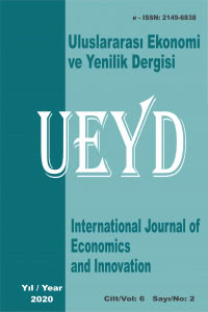Avrupa Birliği Ülkelerinin Boşanma Oranı Analizi
Bu makale Markov zincir modelini kullanarak kaba boşanma oranlarını tahmin etmektedir. Markov modelleri 27 Avrupa Birliği ülkesinin boşanma oranları için oluşturulmuştur. Boşanma oranları, başlangıç olasılık matrisi ve geçiş olasılığı matrisinin çarpımı ile tahmin edilir. Tahminlerin limit matrisleri bulunmuştur. Bu çalışmanın temel sonuçları şunlardır: i) 2015 yılı itibarıyla üst kategoride gerçekleşen boşanma oranlarının uzun vadede aynı kategoride kalması. ii) Sadece Belçika’nın kaba boşanma hızı, mutlaka AB 2015 ortalamasının üzerinde gerçekleşecek ve durağan kalacaktır. iii) Üç ve dört kategoriye sahip Markov modellerine dayanılarak, 2018 boşanma oranları büyük olasılıkla daha düşük kategorilerde gerçekleşecek ve durağan hale gelecektir, iv) Türkiye'nin ham kaba boşanma hızı uzun vadede kesinlikle AB 27'nin 2015 ortalamasının altında kalacaktır ve v) Beş kategori ile oluşturulan Markov modellerine göre başlangıç boşanma olasılığı üst kategorilerde olan ülkelerin boşanma hızının üst kategorilerde ve başlangıç olasılığı alt kategorilerde olan ülkelerin boşanma hızının ise alt kategorilerde durağanlaşacaktır.
Anahtar Kelimeler:
Boşanma Hızı, Geçiş Olasılıkları, Markov Analizi
Analysis of the European Union Divorce Rates
This article estimates crude divorce rates using Markov chain model. Markov models are constructed for the divorce rates of 27 European Union countries. Divorce rates are estimated by the product of the initial probability matrix and transition probability matrix. Limiting matrices of the estimations are found. Main results of this study are i) divorce rates in higher categories in 2015 stay in the same categories in the long run, ii) Only Belgium’s crude divorce rate will certainly be realized and be stationary over 2015 mean of EU 27, iii) Based on Markov models with three and four categories, 2018 divorce rates will more likely be realized and be stationary in lower categories, iv) Turkey’s crude divorce rate will certainly be under 2015 mean of EU 27 in the long run, and v) Based on Markov model with five categories, the divorce rate of the countries with higher likelihood of divorce in the upper categories will be stationary in the upper categories and the divorce rate of the countries with lower likelihood of starting in the lower categories will be stationary in the lower categories.
Keywords:
Divorce Rates, Transition Probabilities,
___
- Balestrino, A., Ciardi, C., ve Mammini, C., (2013), “On the Causes and Consequences of Divorce”, The Journal of Socieconomics, 45, 1-9.
- Crosby, J., F., (1980), “A Critique of Divorce Statistics and Their Interpretation”, Family Relations, 29(1), 51-58.
- Eurostat (2017), http://ec.europa.eu/eurostat/statistics-explained/index.php/File:Crude_divorce_rate,_selected_years,_1960-2015_(per_1_000_persons).png
- González-Val, R., ve Marcén M., (2012), “Breaks in the Breaks: An Analysis of Divorce Rates in Europe”, International Review of Law and Economics, 32(2), 242-255.
- González, L. ve Viitanen, T., K., (2009), “The Effect of Divorce Laws on Divorce Rates in Europe”, European Economic Review, 53(2), 127-138.
- Hiller, V., ve Recoules, M., (2013), “Changes in Divorce Patterns: Culture and the Law”, International Review of Law and Economics, 34, 77-87.
- Kıral, E., ve Mavruk, C., (2017), “Tax Declaration Rates Via Audits: A Prediction Using Markov Model”, Journal of Business Economics and Finance, 6(2), 97-111.
- Kneip, T., ve Bauer, G., (2009), “Did Unilateral Divorce Laws Raise Divorce Rates in Western Europe?”, Journal of Marriage and Family, 71(3), 592-607.
- Meagher, J., (2015), “Why does Ireland have the lowest divorce rate in the EU?” https://www.independent.ie/life/family/family-features/why-does-ireland-have-the-lowest-divorce-rate-in-the-eu-34217513.html
- Smith, S., Maas, I., ve Tubergen, F., (2012), “Irrencilable Differences? Ethnic Intermarriage and divorce in the Netherlands, 1995-2008”, Social Science Research, 41, 1126-1137.
- Wagner, M., ve Weiβ, B., (2006), “On The Variation of Divorce Risks in Europe: Findings From a Meta-Analysis of European Longitudinal Studies", European Sociological Review, 22(5), 483-500.
- ISSN: 2149-6838
- Yayın Aralığı: Yılda 2 Sayı
- Başlangıç: 2015
- Yayıncı: Seyfettin Artan
Sayıdaki Diğer Makaleler
Kişisel Verilerin Korunması: Türk Bankacılık Sektörü Üzerine Kavramsal Bir Değerlendirme
Avrupa Birliği Ülkelerinin Boşanma Oranı Analizi
Hisse Senedi Piyasa Fiyatlarının Saklı Markov Modeli İle Tahmin Edilmesi: Türkiye Örneği
Ekonomik Yatırım Araçları Getirilerinin Saklı Markov Modeli ile Tahmin Edilmesi: Türkiye Örneği
Türk İmalat Sanayinde Performans, İnovasyon ve Rekabet Arasındaki İlişki
